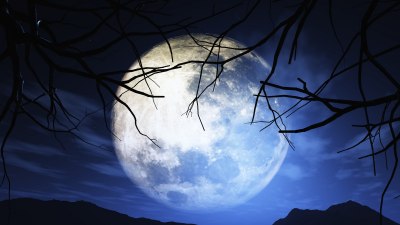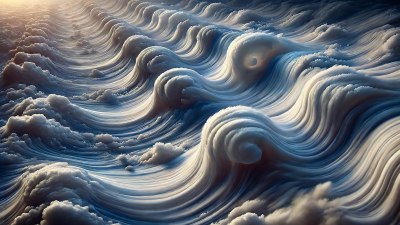Why the Moon Always Looks Like It Knows Something You Don’t
Explore the mystique of the Moon and why it appears to have secrets untold.

Image by kjpargeter on Freepik
The Moon has captured human imagination for millennia, sparking myths, art, and scientific inquiry. Its bright presence in the night sky prompts awe and curiosity, making many wonder whether it holds secrets beyond our understanding. This mystique may stem from various factors, including its physical characteristics, the physics of light, and cultural interpretations.
Physical Characteristics of the Moon
The Moon, Earth's only natural satellite, has a diameter of about 3,474 kilometers and orbits our planet approximately every 27.3 days. Its surface is marked by craters, maria, and highlands, forming a landscape that tells the story of its geological history. Unlike Earth, the Moon lacks an atmosphere, which means it does not experience weathering or erosion. This lack of atmospheric phenomena allows us to see the Moon's surface in remarkable detail and link its features with various tales and interpretations.
The Physics of Light
One of the factors that contribute to the Moon's enigmatic aura is the way it reflects light. It does not emit light; instead, the Moon's surface reflects sunlight. Depending on its position relative to the Earth and the Sun, the Moon appears to glow differently. During a full moon, it shines brightly against the dark canvas of the night sky, whereas during a new moon, it becomes nearly invisible. This shifting visibility leads to various cultural interpretations, as many peoples throughout history have connected these lunar phases to their own lives, often viewing the Moon as a harbinger of change or an omen.
The Mythology Behind the Moon
Throughout history, numerous cultures have woven the Moon into their mythology. In ancient Greece, the Moon was personified as Selene, a goddess who drove her chariot across the night sky. Similarly, in Roman mythology, Luna represented the Moon's qualities of illumination and emotion, often linked to intuition and mystery. In many Native American cultures, each full moon signifies a specific time for seasonal changes, gathering, or hunting. These narratives contribute to the perception that the Moon is not just a celestial body but a keeper of secrets and a witness to human struggles and triumphs.
The Psychological Aspect of the Moon
From a psychological standpoint, the Moon can stir something deep within us. Humans are inherently drawn to its presence, likely due to the Moon's consistent and rhythmic patterns in our lives. The Moon's cycles can influence human behavior, according to various psychological studies. Researchers have looked into how lunar phases can affect sleep patterns, mood, and even crime rates. Known as the lunar effect, the idea that the lunar cycle impacts our behavior only adds to the Moon's mysterious reputation and its association with hidden knowledge.
The Moon in Literature and Art
Literature and art echo the Moon's enigma and its capacity to inspire. From the melancholy poetry of John Keats to the whimsical paintings of Vincent van Gogh, artists and writers often portray the Moon as a symbol of longing, mystery, and unattainable knowledge. In works like Keats's “Endymion,” the Moon represents beauty that is both alluring and distant, further expanding the idea that it “knows” something profound about existence. The Moon serves as a backdrop for narratives exploring love, fate, and the unknown, solidifying its role as a symbol of the secrets of the universe.
Scientific Discoveries and the Moon
The Moon's surface is not just a canvas for artistic expression; it has been a focal point for scientific discovery. The Apollo program's lunar missions expanded our understanding of Earth's history, particularly its formation and geological activity. The Moon remains pivotal in the study of planetary formation and evolution, leading scientists to posit that understanding its secrets can unlock mysteries about our own planet. The presence of water ice at lunar poles suggests potential resources for future missions, further fueling our curiosity about what lies beneath its surface.
The Moon's Influence in Modern Culture
In contemporary culture, the Moon continues to capture our collective imagination. From science fiction films to inspirational songs, artists still draw inspiration from it, depicting the Moon as a magical realm teeming with possibilities. The idea of a lunar colony has become a topic of interest in scientific communities and among space enthusiasts alike. Speculations about extraterrestrial life or ancient civilizations existing on the Moon only add layers to its allure, intensifying the belief that the Moon possesses wisdom beyond our reach.
Perception of the Moon in Technology
Advancements in technology enhance our understanding and perception of the Moon, revealing its complex details in high resolution. The use of telescopes and lunar probes has allowed us to capture stunning images and make groundbreaking discoveries. With each technological leap, we unveil more of the Moon's surface and its potential, diminishing some aspects of its mystery but also introducing new questions. This current era of lunar exploration reminds us that while we may be uncovering more truths, the Moon still holds answers we have yet to discover.
The Moon stands as a symbol of mystery, beauty, and potentially hidden truths. Its influence spans mythology, psychology, science, and art, embodying the struggle between knowing and believing that something remains unknown. As we continue our journey in studying the cosmos, the Moon will undoubtedly persist as a fascinating object of interest, a reminder of the wonders that await exploration. Whether viewed as a celestial body or a metaphor for human experience, the Moon endlessly invites us to ponder its secrets and our own place in the universe.











